® - Registered trademark.
RA - Acronym for the Resettlement Administration, an agency of the U.S. government in the Agriculture Department during the Great Depression of the 1930s and 1940s. It was a part of the federal bureaucracy which administered New Deal art programs. It later became the Farm Security Administration (FSA). "RA" is also an acronym for the Britain's Royal Academy (or Royal Academy of Arts).
 rabbet - A groove along the window edge
on the back of a frame.
It allows for the greater protection and shallower or deeper placement
of glass, mat,
picture, etc. It might be
produced with such tools as a rabbet plane or a router.
rabbet - A groove along the window edge
on the back of a frame.
It allows for the greater protection and shallower or deeper placement
of glass, mat,
picture, etc. It might be
produced with such tools as a rabbet plane or a router.
 rabbit skin - The source for glue
size traditionally used
in preparing a ground for
oil painting.
rabbit skin - The source for glue
size traditionally used
in preparing a ground for
oil painting.
Related resource:
![]()

radial, radiate,  and
radial balance - Radial means anything of, relating to,
or arranged like rays.
and
radial balance - Radial means anything of, relating to,
or arranged like rays.
Radial or rotational balance is any type of
balance based on a circle
with its design  extending
from or focused upon its center.
extending
from or focused upon its center. A star,
the iris around each pupil
of your eyes, a wheel with spokes, and a
daisy (among many flowers and other plant
forms) are examples of radial balance.
Other examples:

Rosette from the ancient Temple of Jupiter,
Capitoline Hill, Rome, from a hand-colored engraving published by Carlo Antonini
in 1781, plate 12. The Temple of Jupiter was the principal religious
structure of ancient Rome. This rosette
was apparently carved stone. Although this architectural
feature may have been polychromed
in its original state, the colors in this engraving are highly
speculative. The enlarged view includes a cross-section
of the rosette. This engraving is one of a set of 100, some of
which can be purchased from lombardmaps.com. See Roman art.

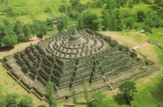
Borobudur (at two seasons of the year) — one of the most magnificent
Buddhist shrines in the world — was built at the end of the
9th century by the Hindu kings of the Sailendra dynasty. Borobudur
is located 42 kms west of Yogyakarta, on the island of Java in
Indonesia. The plan
for this stupa is a schematized representation of the cosmos,
a mandala. After visiting its lower terraces decorated with bas-relief,
pilgrims attain the shrine's crowning stupa, which symbolizes the Absolute.
Also see plan and representation.
![]()

France, Rose Window of the Cathedral of Notre
Dame of Paris, interior view.
![]()

Exterior view showing the fine stone tracery — the openwork so structurally important to the window.
Work on this Gothic cathedral began in 1163 and was completed 1345. See rose window and stained glass.

England, 17th century, Charger of Charles II in the Boscobel Oak , c. 1685, lead-glazed earthenware with slip decoration, diameter 17 inches (43.2 cm), Los Angeles County Museum of Art.
![]()
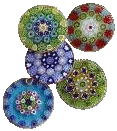

Italian, Murano, Millefiori, contemporary,
glass. The average
diameter of the millefiori
to the right is 3 mm.
![]()
![]()

A photograph of what could be seen in one old kaleidoscope.
See kaleidoscope.
![]()

What could be seen in another kaleidoscope.

Roy Lichtenstein (American, 1923-1997), Wall Explosion II, 1965, enamel on steel
relief, 170.2 x 188.0 x 10.2 cm,
110 kg, Tate Gallery, London. Lichtenstein's cartoon-style
explosion displays a type of balance
called radial symmetry. This composition's departures from a regular, circular arrangement adds to our interpreting it as a synthesis of order and chaos in its movement. See Pop Art.

Carrie Severt (American, contemporary), Star
quilt, 1978, a contemporary
use of a traditional quilt
design, photo from Quilts and
Quiltmaking in America: 1978-1996, Library of Congress. See
textile.

Christoph Hormann (German, 1979-), Star, 2001-02, digital
image produced by combining several spiral
and radial patterns,
using Persistence
of Vision Raytracer (POV Ray) software.

![]()

![]()

![]()

Japan, four watermelons,
 each carved with radial designs (first, second, third, and fourth), and displayed on a table, 2004. William C. Lamb posted about thirty-four photos of vegetables, some carved to depict figures, some with texts, all examples of an apparently
each carved with radial designs (first, second, third, and fourth), and displayed on a table, 2004. William C. Lamb posted about thirty-four photos of vegetables, some carved to depict figures, some with texts, all examples of an apparently popular artform among culinary artisans in Japan, in some ways related to western traditions of cake decoration, pumpkin carving, and ice sculpture, in that each of these too are temporary kinds of works often produced in kitchens as studios. See cameo, folk art, gyotaku, ikebana, Japanese art, origami, relief, and suiseki.

Also see actino-, color wheel, curve, mandala, millefiori, pattern, principles of design, ray, rondel (or roundel or rondelle), and tondo.
radiate - See ray.
radiograph - An image produced by radiation other than visible light, especially by x-rays passed through an object or by photographing a fluoroscopic image, on a radiosensitive surface, such as a photographic film. Radiographs are sometimes made of art objects to better see what is beneath their surfaces, in hopes of revealing information about their making, and alterations over time. Typical examples are radiographs of mummies, and of paintings that have been painted over, are in need of conservation, or are suspected forgeries.
Also see fluorescence, infrared reflectography (IR) and reflectogram, and overpainting.
radius -![]()
 A straight line
from the center of a circle to any
point on its circumference,
or from the center of a sphere
to any point on its surface,
and the length of any such
line. Also, a long, slightly curved
bone, the shorter and thicker of the two forearm bones, located
on the lateral side of the
ulna. The plural form can be either radii or radiuses. Double
the radius and you have the diameter.
A straight line
from the center of a circle to any
point on its circumference,
or from the center of a sphere
to any point on its surface,
and the length of any such
line. Also, a long, slightly curved
bone, the shorter and thicker of the two forearm bones, located
on the lateral side of the
ulna. The plural form can be either radii or radiuses. Double
the radius and you have the diameter.
(pr. RAY-dee-əs)
Also see radial, radiate, and ray.
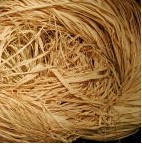
![]()
 raffia - An African palm tree having large fibrous leaves. The leaf fibers
of this plant are processed into materials
used for many craft purposes, often
in carpets, baskets, and hats. It is most commonly available in
its natural, tan color, but can also be obtained bleached, and
dyed in many colors.
raffia - An African palm tree having large fibrous leaves. The leaf fibers
of this plant are processed into materials
used for many craft purposes, often
in carpets, baskets, and hats. It is most commonly available in
its natural, tan color, but can also be obtained bleached, and
dyed in many colors.
(pr. RA-fee-ə)
Also see African art, applied arts, cane and caning, furniture, mask, rattan, reed, rush, textile, and wood.
raising - The shaping of a malleable metal such as silver or gold by hammering it around a domed model generally of pitch, to extend it from a sheet to a hollow form.
Also see boss, emboss, relief, repoussé, sinking, and wrought iron.
raisonné - See catalogue raisonné.
raking cornice - In architecture, the cornice on the sloping sides of a pediment.
raking light - Light cast upon a surface at an acute angle enlarging shadows cast by elements of the surface's texture or of a relief sculpture, increasing the contrast of its luminosity.
Example:

Abelardo Morell (American, born Cuba, 1948-), 1841 Book of Proverbs for the Blind, 1995, photograph of a book illuminated by a raking light which reveals that all lettering on the book's pages were embossed.
Also see gradation, projection, and value scale.
raku - Porous low-fired ceramic ware characterized by deep, subtly changing colors.
(pr. ra-KOO)
Ramayana - In Hindu tradition, a Sanscrit epic telling of Rama, an incarnation of the Hindu god Vishnu.
rare - One of a kind, or of a very limited number.
Also see collect, collectible, edition, market value, and philately.
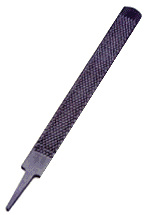
rasp - A coarse and
abrasive tool
made of metal (usually steel). The abrasive surface has many pointed teeth
shaped like tiny pyramids, and typically the surrounding surface
is  perforated so that
dust doesn't clog it. Rasps are used in shaping and smoothing
wood, plaster,
ivory, stone,
etc. Files are generally more
finely abrasive than rasps, while rifflers
are the most finely abrasive of all rasps.
perforated so that
dust doesn't clog it. Rasps are used in shaping and smoothing
wood, plaster,
ivory, stone,
etc. Files are generally more
finely abrasive than rasps, while rifflers
are the most finely abrasive of all rasps.
Also see surform.
raster image - See bit-mapped image.
rathas - In Hindu tradition, small, freestanding temples, perhaps sculptured as architectural models.
ratio - The relationship between two or more similar things in size, number, or degree. The numerator and denominator of every fraction function in this way. For example, "1/2" represents the ratio between one and two: one of two equal parts that together make a whole. 3/6 and 50/100 are similar ratios. Ratios are often expressed as numbers separated by a colon, and read as "is to." Analogies are often made using ratios. An example is 50:100 as 1:2. Ratio is essential to scale and proportion, and to the particular type of proportion known as the Golden Mean.
(pr. RAY-shee-oh)
Another example:
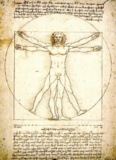
Leonardo da Vinci (Italian, 1452-1519), Study
of proportions, from Vitruvius's De Architectura, pen and ink,
13 1/2 x 9 5/8 inches (34.3 x 24.5 cm), Accademia, Venice. Leonardo,
inspired by the mathematician
Vitruvius (Roman, 1st century BCE),
drew this famous picture of Vitruvian Man — a sort of ideal
figure — whose arm
span is equal to his height — a ratio of one, or 1:1. See a page with a math lesson plan for grades 6-8,
as well as articles on drawing, humanism, and Renaissance.
Also see dimension, graph, grid, pointing machine, and projection.
rational - Consistent with or based on reason; logical. This is relative to several factors, including context; as, for instance, in a culture whose thinking is classical, idealizing, or scientific.
rattan - A plant, and all materials derived from it — primarily cane and reed — have been used largely in the production of baskets and wicker furniture. It is obtained from such areas as as China, Southeast Asia, Malaysia and the Philippines. Its earliest use in basketry has been dated to the third millennium BCE. Rattan has been used as the framework for wicker furniture since the mid-19th century, although most wicker from the 1870s-1940s was made with a wooden structure.
Rattan is both a vine and a palm, known to grow along the ground and up into jungle trees, reaching lengths of up to 600 feet and diameters of up to four inches. Rattan has a thorny bark that must be removed to reveal the inner skin, from which cane is made, with a naturally glossy surface. Reed comes from the pithy core of rattan.
(pr. rə-TAN)
Also see bamboo, dowel, raffia, and rush.
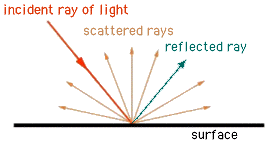 ray - A thin line
or narrow beam of light, or a representation of such a straight line. A structure
or part having the form of a straight
line extending from a point;
ray - A thin line
or narrow beam of light, or a representation of such a straight line. A structure
or part having the form of a straight
line extending from a point;
 and when there are several such
lines extending from one point, they may be said to radiate from
that point, as points radiate from a star.
and when there are several such
lines extending from one point, they may be said to radiate from
that point, as points radiate from a star.
Also see actino-, circle, girandole, incident light, light, radial balance, radius, reflection, refraction, and surface.
rayograph - In the work of Man Ray (American, 1890-1977), a photogram.
Rayonism - A type of abstract or semi-abstract painting characterized by the fragmentation of forms into masses of slanting lines. It was practised from 1912-1914 by Natalya S. Goncharova (Russian-French, 1881-1962), Mikhail Larionov (Russian-French, 1881-1964), and a few other Russian painters. Larionov's manifesto on Rayonism stated that it is a synthesis of Cubism, Futurism, and Orphism." Aspects of each of those isms can indeed be seen in Rayonist paintings — Cubism's breaking up of forms, Futurism's movement of forms, and Orphism's rich color. In addition, the Rayonists expounded a theory that objects emitted invisible rays which the painters could manipulate to their own purposes. "The rays which emanate from the objects and cross over one another give rise to rayonist forms. The artist transforms these by bending them to his desire for aesthetic expression." Goncharova and Larionov often applied the paint in their Rayonist works with palette knives.
Also called "Rayonnism," "Rayism," and, in Russian, "Luchism."
Examples:
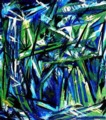
Natalya S. Goncharova (Russian, 1881-1962),
Green
Forest, 1912, oil
on canvas.

Natalya S. Goncharova, Rayonist Composition, c. 1912-3, pastel on paper,
31.8 x 21.6 cm, Tate Gallery, London.

Mikhail Larionov (French, born Russia, 1881-1964),
Rayonist
Composition: Domination of Red, 1912-13, dated on painting
1911, oil on canvas,
20 3/4 x 28 1/2 inches (52.7 x 72.4 cm), Museum of Modern Art,
NY.

Mikhail Larionov,
Rayonist
Composition, c. 1912-13, oil
on cardboard, 20 x 17 1/8
inches (50.2 x 43.5 cm), Museum of Modern Art, NY.

Mikhail Larionov, Spring, 1912, oil
on canvas, 86.5 x 68.2 cm,
Georges Pompidou Center, Paris. See primitive.
Also see Constructivism, Cubism, Futurism, Orphism, Suprematism, and Vorticism.
rayonnant - The "radiant" style in thirteenth century architecture that is associated with the royal Paris court of Louis IX (1214-1270), the French king also known as Saint Louis.
readability - In typography and any written text, the degree to which it is legible. In any text, very rarely is the need to convey a style more important than it is to communicate its meaning. Although lettering should be attractive, readability is usually the most important factor in its design.
realgar - A particular red pigment.
Related resource:
realia - Material culture,
or objects from real life,
in contrast to those objects
typically included in a collection.
A piece of realia draws attention either because it is a common
example of its kind — as an exemplum rather than as an exemplar — or because of associations with its previous owner. Some such
objects might also be described as artifacts, ephemera, bric-a-brac, gewgaws, found
objects, or memorabilia,
but they are seldom prized for any qualities of their design, for their fine materials, or for the craftsmanship with which they were made.
Realia includes objects used by
educators to help students to understand
other cultures and real life situations.
![]()

![]() A teacher of a foreign language
employs realia to strengthen students' associations between words
for everyday objects and the objects themselves. Examples might
include an apple, a shoe, a menu, a fork, a door, etc.
A teacher of a foreign language
employs realia to strengthen students' associations between words
for everyday objects and the objects themselves. Examples might
include an apple, a shoe, a menu, a fork, a door, etc.
A library is more likely to prize
realia for its associations with writers, subjects, or themes
in the library's collection of media.
The library at Yale prizes Eugene O'Neill's lighter, while Sir
Arthur Conan Doyle's golf clubs gather dust at the U of Texas.
The Bertrand Russell Archive at the McMaster  U
in Ontario hangs on to two Vietnam-era cluster bombs, deactivated
but genuine. Such realia is akin to relics,
memorabilia, and souvenirs. (What bookman wouldn't be thrilled
to accession Ernest Hemingway's fishing rod or William Shakespeare's
eraser! [Do you suppose he had one?!])
U
in Ontario hangs on to two Vietnam-era cluster bombs, deactivated
but genuine. Such realia is akin to relics,
memorabilia, and souvenirs. (What bookman wouldn't be thrilled
to accession Ernest Hemingway's fishing rod or William Shakespeare's
eraser! [Do you suppose he had one?!])
There is no singular form for this word, because realia refers to a group of or classification of things.
(pr. rə-YA-lee-ə)
ArtPage has yet to find citations of this term used by art writers, art gallery or museum staff. There are many citations of its use by librarians and educators.
Quote:
"These unanticipated acquisitions
are referred to in the trade [by librarians] variously as personal
effects, ephemera, artifacts, memorabilia, and perhaps most evocatively,
realia."
Lev Grossman, "Catalog This: Dante's dust, Poe's hair, Taft's
underwear. Oh, my, what's a librarian to do?" April 14,
2002, New York Times, Education Life section, page
26.
Examples:
 (aliases
for David Cody, English professor, Hartwick College, Oneonta,
NY) — make incredible
(aliases
for David Cody, English professor, Hartwick College, Oneonta,
NY) — make incredible 
Also see archetype, description, kitsch, memorabilia, memory, provenance, readymade, and simulation.
ream - 500 sheets of paper.
rebate - In framing, this is the step-shaped cut in the reverse side of the molding which accepts the edge of the canvas, panel, etc.
rebus - Pictures or symbols presented as representing words, and often acting as a puzzle, usually for children.
(pr. REE-bəs)
Examples:

David C. Lovelace (American, contemporary),
What
year was color TV first broadcast?, 1999. The puzzle
begins with "W, nut minus the N, Y ear . . . . " See
Dave's site about his art / cartoon / graphic design work at
umop.com.
These images can be read as "B-E to B-I"
— a rebus employed as the title of one page of ArtPage.
Also see children's art and mathematics and art.
recreation -
Quote:
rectilinear and rectilineal - Moving in or forming a straight line. Also, characterized by straight lines. "Rectilinear" comes from the late Latin "rectilineus," which itself comes from the Latin words "rectus" ("straight") and "linea" ("line"). "Rectilineal" is a synonymous form of this word. Because "rectilineal" remains far less popular than its relative, writers might as well avoid it unless there's a need to rhyme with anneal.
(pr. REK-tə-LI-nee-ər and REK-tə-LI-nee-əl)
Also see lattice, linear, linear perspective, rectangle, and rectangular.
A term that is distantly related to rectilinear is "rectitude," the formal, dignified bearing adopted by proctologists.
recto - The front side of any work on paper. May also be the right-hand page of a book. The opposite of verso. The front and rear sides of other two-sided objects, such as coins, medals, or panels which have a painting on each side are more often referred to as obverse and reverse.
Also see numismatics.
red-figure - In later ancient Greek pottery, a technique in which red figures were silhouetted against a black background.
Examples:

Greece, Attic, attributed to the Berlin Painter,
Amphora, c. 490 BCE,
Classical, red-figure, terra cotta,
height 16 5/16 inches (41.50
cm), Metropolitan Museum of Art, NY. On the obverse a young man
sings as he plays the kithara; on the reverse is a judge. See
amphora, black-figure,
vase and vessel.

Greece, Attic, attributed to the Villa Giulia
Painter, Kylix, c. 470 BCE,
Classical, red-figure and white-ground,
terra cotta, height
2 7/16 inches (6.2 cm), Metropolitan Museum of Art, NY. On the
interior, a goddess stands beside an altar,
about to pour an offering from a phiale; on the exterior, obverse and reverse, Eos pursues
Tithonos. See kylix.

Greece, South Italian (Apulian), attributed
to the Group of Boston 00.348, Column-krater, c. 360-350 BCE,
red-figure terra
cotta, height 20 1/4 inches
(51.51 cm), Metropolitan Museum of Art, NY.
reduction firing - A method of producing greater depth of color on a clay body by firing ceramics with reduced oxygen in the kiln.
reed - A natural, fibrous weaving material used in the production of baskets and wicker furniture. The inner pith of the rattan plant is called reed. Its grain makes its appearance similar to a wood. Reed has a certain brittle quality. It comes in various dimensions. Reed is more porous than cane, and will accept a stain, paint, lacquer or varnish.
Also see bamboo, cane and caning, furniture, raffia, and rush.
reflected color - The color perceived from an object, determined by the wavelength of the light leaving its surface after selective absorption of other wavelengths of the incident light — the light hitting the surface. Reflected light behaves in certain ways that differentiate it from colors produced by sources of the light. The concept of reflected color is related to that of subtractive color — color produced by mixing cyan, yellow and magenta pigments, each of which absorbs certain wavelengths. A balanced mixture of these colorant or subtractive primaries theoretically yields black since it absorbs all wavelengths of visible light.
Also see additive, local color, optical mixing, and primary colors.
 reflection,
reflected image - An image
given back by a reflecting surface,
such as that of a mirror or still
waters. Each ray of light
that hits a surface is an incident
ray of light. Rays that are neither absorbed, nor reflected,
are scattered rays of light. A person sees a clearer reflection
when a high number and percentage of rays are reflected, and a
small number of rays are either absorbed or scattered.
reflection,
reflected image - An image
given back by a reflecting surface,
such as that of a mirror or still
waters. Each ray of light
that hits a surface is an incident
ray of light. Rays that are neither absorbed, nor reflected,
are scattered rays of light. A person sees a clearer reflection
when a high number and percentage of rays are reflected, and a
small number of rays are either absorbed or scattered.
Examples of art in which reflection is important:

George Caleb Bingham (American, 1811-1879),
Fur Traders Descending the Missouri,
c. 1845, oil on canvas,
29 x 36 1/2 inches (73.7 x 92.7 cm), Metropolitan Museum of Art,
NY.
William Morris Hunt (American, 1824-1879), Governor's Creek, Florida, 1874, oil on canvas, 25 x 39 inches, Fine Arts Museums of San Francisco, CA.

Claude Monet French, 1840-1926, The Seine at Port-Villez, 1894, oil
on canvas, 65.4 x 100.3 cm,
Tate Gallery, London. See Impressionism.
Thomas Eakins (American, 1844-1916), The Champion Single Sculls (Max Schmitt in a Single Scull), 1871, oil on canvas, 32 1/2 x 46 1/4 inches (82.6 x 117.5 cm), Metropolitan Museum of Art, NY. See Realism.

Childe Hassam (American, 1859-1935), Nocturne,
Railway Crossing, Chicago, 1893, watercolor on paper,
16 x 11 3/4 inches (40.6 x 29.8 cm), Museum of Fine Arts, Boston.
Hassam layered subtly varied blue washes
to evoke pavement, skyscrapers, streetcars, and horse-drawn carriages
and added highlights to capture
glowing lights and their reflections
on the wet street. See American
Impressionism, nocturne,
and Ten American Painters.

Maurits
Cornelis Escher (Dutch, 1898-1972), Hand with Reflecting Sphere, 1935, lithograph,
32 x 21.5 cm. See sphere.

Maurits Cornelis Escher, Three Spheres II, 1946, lithograph. Here Escher realistically
depicts a range of ways that materials
with various properties reflect light. The first sphere is of
glossy and transparent glass, the one in the center has a mirrored surface, and the third has
a matte white one.

Maurits
Cornelis Escher, Reflection, 1950, linocut
printed from two blocks, 26 x 32 cm. Two raindrops have fallen
into a pond, and, with the concentric, expanding ripples that
they cause, disturb the still reflection of a tree with the moon
behind it. See World
of Escher.

Maurits Cornelis Escher, Puddle, 1952, woodcut in black, green and brown, printed
from 3 blocks.
Also see absorption, anamorphosis, dark, finish, glossy, light, refraction, and sight.
reflectogram and reflectography - See infrared reflectography (IR) and reflectogram.
reflexivity - The process of making one self-aware of one’s immersion in visual culture to examine one’s own position, and hidden influences, sometimes through intertextuality.
Also see visuality.
Reformation - A religious revolution in western Europe that took place during the sixteenth century. It began as a reform movement within the Roman Catholic Church but evolved into the doctrines of Protestantism.
Also see Baroque.
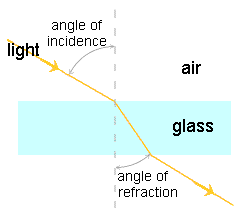
refraction, refract - Refraction is the change in direction which occurs when rays of light pass from one medium to another of a different density, as they do from air to glass or water. Or, the distortion of an image by seeing through a translucent medium. To refract is to cause such a change in the direction of light. Ophthalmology is concerned with the eye's refractive ability: changing the direction of light in order to focus it on the retina. An ophthalmologist measures this refractive ability, resulting in an accurate prescription for lenses which will optically compensate for the eye's inability to achieve focus.
Also see angle, mother-of-pearl, point of view, reflection, refractory, telescope, and wavelength.
refractory - Resistant to high temperatures. Refractory materials are used for molds in lost-wax casting and for kiln furniture on which ceramic ware stands while it is fired.
Also see refraction.
Regency - Refers to one of the periods during which a person or group has been selected to govern in the place of a ruler who is either absent, disabled, or too young to govern. In England, this is the style of design prevalent during the regency from 1811-1820, of the future George IV. An example is Paul Storr's (English, active 1785-1838) Centerpiece, 1810-1811, silver with mark: date letter P, width at base: 18 x 14 inches, Birmingham Museum of Art. Among the French, it refers to the style prevalent during the regency from 1674-1723, of Philippe, Duc d'Orleans.
register, register mark, and registration
- The exact alignment of shapes
or edges in various areas of
any piece of work.  In printmaking,
registration is the proper positioning of plates
or colors. Any mark
made to assist in positioning elements for
better alignment can be called a
In printmaking,
registration is the proper positioning of plates
or colors. Any mark
made to assist in positioning elements for
better alignment can be called a register
mark, registration mark, reg
mark, or an alignment mark.
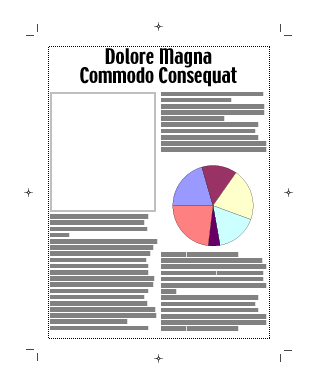 In museum work, registration is the
process of developing and
maintaining an immediate, brief, and permanent means of identifying
an object for which the museum
has assumed responsibility.
In museum work, registration is the
process of developing and
maintaining an immediate, brief, and permanent means of identifying
an object for which the museum
has assumed responsibility.
In this
page layout, register marks
have been placed outside of the sides of the printed area, here
surrounded by a dotted-line.
Register marks should not be confused with crop
marks — placed outside of each corner of the printed area
of this example, showing where material should be cut off after the image has been produced. In this case, a white margin will remain once the page has been cropped.
See graph.
Also see accession, bleed mark, ear, fold, graphic design, and registrar.
registrar - A person with broad responsibilities in the development and the enforcement of policies and procedures pertaining to the acquisition, management and disposition of collections. The registrar maintains the records pertaining to the objects for which the institution has assumed responsibility. Usually the registrar also handles arrangements for accessions, loans, packing, shipping, storage, customs, and insurance as it relates to the objects.
Also see art careers, curator, museology, museum, preparator, register, and typology.
regular - Uniformly or evenly formed or arranged. Circles, squares, and equilateral triangles must all be regular shapes. Some ovals and some quadrilaterals are regular. No amorphous shapes or biomorphic forms can ever be regular.
Also see straight.
https://inform.quest/_art